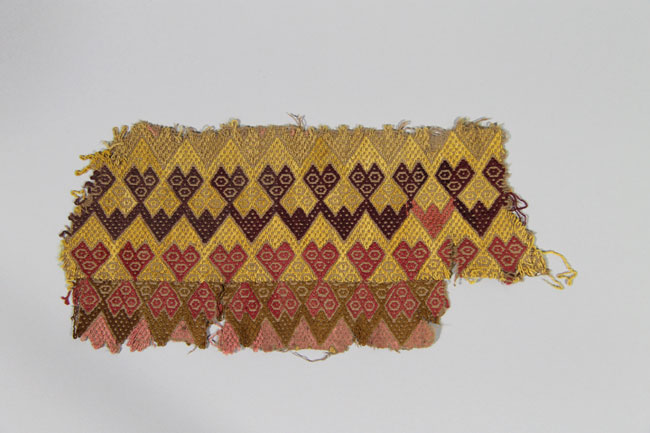
TRADITION, SETH SIEGELAUB AND THE CENTRE FOR DYING ON STAGE
FROM 8 JUNE TO 11 AUGUST 2013
TRADITION A selection from the Center for Social Research on Old Textiles (CSROT)
Woven patterned textile (fragment), Peru, circa 16th century, 9,5 x 6,3 cm, wool, cotton. Courtesy of Center for Social Research on Old Textiles | ||
With works by Willem Oorebeek, Lucy Skaer and Christopher Williams The Grazer Kunstverein continues its exploration within the realms of social abstraction, by presenting a selection of the elaborate collection of historic textiles assembled by Seth Siegelaub (1941, US) for the Center for Social Research on Old Textiles. Currently comprising of around 650 pieces, the collection includes woven and printed textiles, embroideries and costume, ranging from fifth-century Coptic to Pre-Columbian Peruvian textiles, late medieval Asian and Islamic textiles, and Renaissance to eighteenth-century European silks and velvets. At Marres, a selection of 50 items will be shown alongside art works. The exhibition follows The Stuff That Matters at Raven Row (London) in 2012, which marked the collection’s first public presentation. After running his own gallery in New York from 1964 to 1966, Seth Siegelaub played a pivotal role in the emergence of what became known as Conceptual Art, which resulted in a series of 21 art exhibitions in groundbreaking formats he organized between 1968 and 1971. In 1972 he turned away from art and moved to Paris, where he published and collected leftist books on communication and culture, and founded the International Mass Media Research Center. In the early eighties he began collecting textiles and books about textiles and in 1986 founded the Center for Social Research on Old Textiles, which conducts research on the social history of hand-woven textiles. In 1997 he edited and published the Bibliographica Textilia Historiae, the first general bibliography on the history of textiles, which has since grown online to over 9,000 entries. The intimate relationship between textiles and society can be seen, as Siegelaub explains, in the fundamental role textile played in the rise of the capitalist system and the industrial revolution. While the form and aesthetics of textiles in general are determined by the way they are manufactured, the selection of items in the exhibition at the Grazer Kunstverein are specifically based on the abstraction of forms in relation to function. Amongst the items on display will be Barkcloth (tapa) and headdresses from the Pacific region (especially Papua New Guinea) and Africa. The textiles in the exhibition will be shown alongside the works of three artists, Willem Oorebeek, Lucy Skaer and Christopher Williams, whose conceptual work reflects on notions of craftsmanship, industrial (re)production, modernity, appropriation and representation. An essay by artist and writer Doug Ashford is published for the occasion.
The Members Library* presents
The Centre For Dying On Stage The Grazer Kunstverein is thrilled to announce the inauguration of The Centre For Dying on Stage, an ephemeral research residency venture exploring the spectacle of death caused during a performative state. The centre structures, archives, commissions and presents undertakings that investigate notions around death and the stage by looking at cases of those such as Molière, Felix Mottl, Alexander Woolcott, Johnny Ace, Tyrone Power, Harry Einstein, Eduard van Beinum, Leonard Warren, Paul Mantz, Nelson Eddy, Joseph Keilberth, George Ostroska, David Burns, Jerome Rodale, Leslie Harvey, Irene Ryan, Carl Barnett, Chris Chubbuck, Sid James, Cyril Ritchard, Karl Wallenda, Bill Stewart, Arnold Soboloff Ron Watson, Renato Di Paolo, James Tuozzolo, Giuseppe Sinopoli, John Ritter, Gordon Reid, Darrell Abbott, Francesco Scoglio, Craig Ewert, Steve Irwin, M.N. Vijayan, Jose Fernando Castro Caycedo, Miriam Makeba and more recent Jeroen Willems. The Centre’s first researcher is Kate Strain, an Irish curator based in Dublin. Kate has been asked to structure the content and archive of the centre including its website.For further information, please check www.centrefordyingonstage.com On display continuously Ian Wilson 01 Feb 2013 Ian Wilson (*1940, South Africa)is someone in whose work the Grazer Kunstverein’s sees its mission reflected; to explore relationships between the viewed – or discussed – and the viewer and the topical urgency of such interaction. To stress his importance to the program, the Grazer Kunstverein has dedicated a permanent solo exhibition to the artist, which will display different works throughout the years as well as a commissioned and acquired Discussion. The Peacock 01 February 2013- A non-stop group show examining the interior of the Grazer Kunstverein by introducing (new) furniture, design, applied and decorative arts that analyze their own functionality 08 June – 11 August 2013 Nina Beier, Will Stuart and new instalments by Eva Berendes and Josh Faught, Grazer Kunstverein is generously supported by the city of Graz, the Austrian Federal Ministry for Education, Art and Culture, the province of Styria and Legero The Footwear Company and its members. The exhibition ‘Tradition’ is generously supported by the Mondriaan Fund and the Royal Dutch Embassy in Austria. | ||
|
GRAZER KUNSTVEREIN
Palais Trauttmansdorff
Burggasse 4 8010 Graz Austria INFORMATION: • Phone: +43 316 834141 • Website: http://www.grazerkunstverein.org • Fax: +43 316 834142 • Mail : office@grazerkunstverein.org OPENING TIMES: Wed - Sun 11am - 6pm ADMISSION PRICE: regular EUR 3,50 reduced EUR 2,00 CURATORS: Krist Gruijthuijsen, director Grazer Kunstverein and Maxine Kopsa, director Kunstverein, Amsterdam CONTACTS: • Tanja Gurke Phone: +43 316 834141 tg@grazerkunstverein.org • Krist Gruijthuijsen Phone: +43 316 834141 kg@grazerkunstverein.org
|
||

